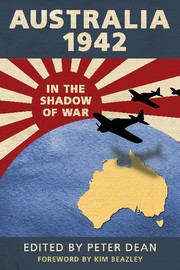Book contents
- Frontmatter
- Foreword
- Contents
- Photos
- Maps
- Charts
- Acknowledgements
- Contributors
- Abbreviations
- Maps
- Introduction
- Part 1 Australia in 1942
- Part 2 Relations, politics and the home front
- Chapter 2 World wars and the anticipation of conflict
- Chapter 3 The overlooked mission
- Chapter 4 The home front and the American presence in 1942
- Chapter 5 ‘Dangers and problems unprecedented and unpredictable’
- Part 3 Australia under threat
- Part 4 The war on Australia’s doorstep
- Index
- References
Chapter 3 - The overlooked mission
Australia and home defence
from Part 2 - Relations, politics and the home front
Published online by Cambridge University Press: 05 January 2013
- Frontmatter
- Foreword
- Contents
- Photos
- Maps
- Charts
- Acknowledgements
- Contributors
- Abbreviations
- Maps
- Introduction
- Part 1 Australia in 1942
- Part 2 Relations, politics and the home front
- Chapter 2 World wars and the anticipation of conflict
- Chapter 3 The overlooked mission
- Chapter 4 The home front and the American presence in 1942
- Chapter 5 ‘Dangers and problems unprecedented and unpredictable’
- Part 3 Australia under threat
- Part 4 The war on Australia’s doorstep
- Index
- References
Summary
When Japanese bombs fell upon Darwin on 19 February 1942 the situation facing Australia appeared grave. Singapore had surrendered, much of the Netherlands East Indies had been overrun, the Japanese had occupied Rabaul and would soon land on New Guinea, and Australia’s 8th Division was in captivity. In addition, the US position in the Philippines had been effectively decided, although the defenders of Corregidor would hold out to 6 May. Making Australia’s position appear even more desperate was that, as David Horner has noted, ‘Most of its trained soldiers were overseas, mainly in the Middle East. The RAAF had few planes in Australia, many of the larger vessels of the small RAN were in distant waters, and the home defence force, the militia, was poorly trained and equipped’. The Japanese advance had been so rapid and unchecked that fear of imminent invasion swept the country and panicky coast dwellers fled inland; even if today we know that the Japanese never had any intention to do so.
This chapter will explore how Australia found itself in this desperate situation. First it will examine the assumptions and decisions that led to Australian territory being virtually bereft of military power as the Japanese threat neared. Second, it will discuss the measures initiated by Australia to remedy this deficiency and the steps taken to convert the country into one of the lines of Allied attack that would lead to Japan’s defeat. In doing so, it will consider the interaction between two broad themes of Australian defence policy: the constant struggle to achieve an appropriate balance between a reliance on a great power protector and the requirements of self-reliance.
- Type
- Chapter
- Information
- Australia 1942In the Shadow of War, pp. 53 - 69Publisher: Cambridge University PressPrint publication year: 2012
References
- 1
- Cited by



